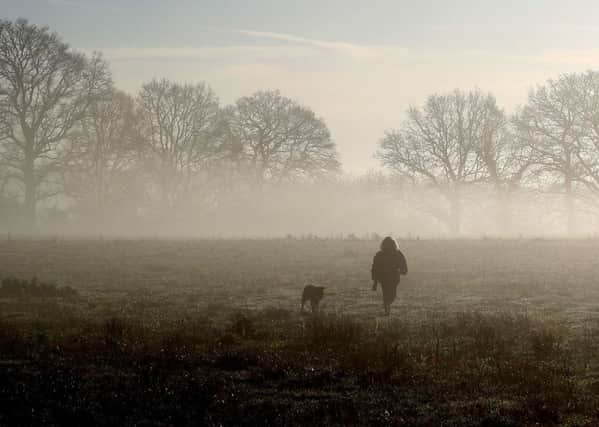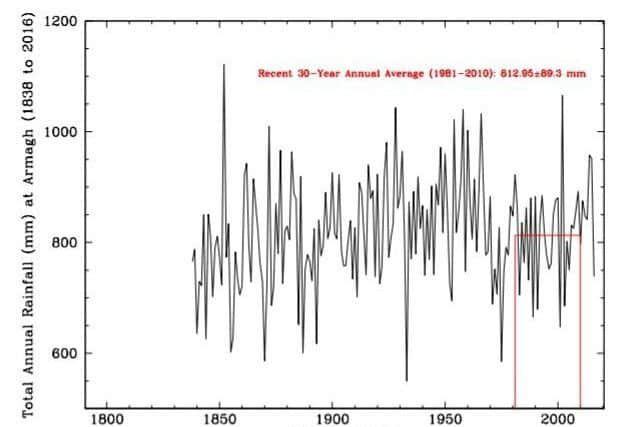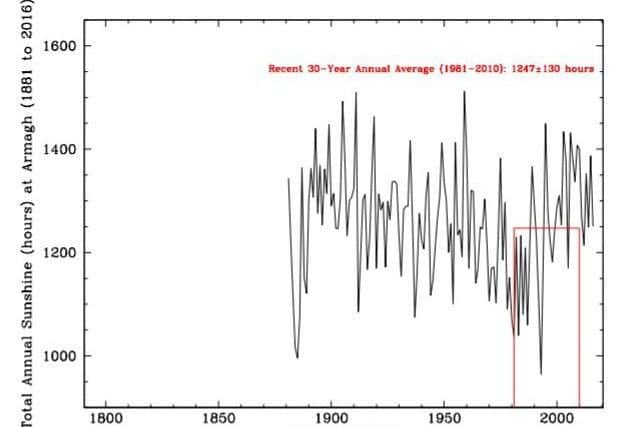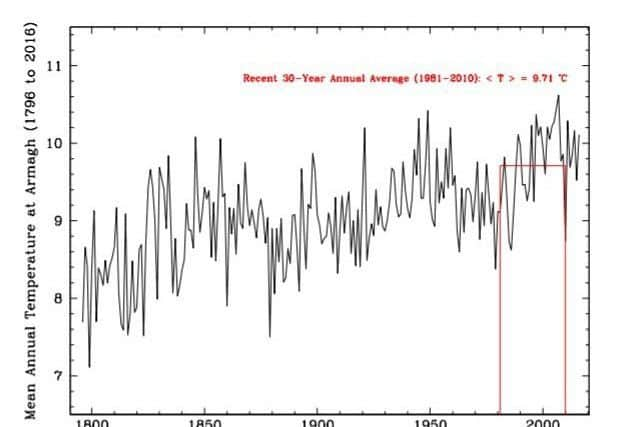2016 warmer and drier than average, with about average sunshine


This was the driest December at Armagh for six years, that is, since the very cold December 2010.
Taking the 12 months of 2016 together, the year as a whole was warmer and drier than average, but with roughly average sunshine.
Advertisement
Hide AdAdvertisement
Hide AdTotal December precipitation was 51.65 mm (2.03 inches) including 5 trace values.


This is roughly two-thirds of both the long-term (1838–2010) average December precipitation at Armagh and the most recent (1981–2010) 30-year average.
The wettest day was the 15th with 13.4 mm (0.53 inches) of rainfall. This was the driest December at Armagh since December 2010.
With a total of 50.5 hours of strong sunshine, December 2016 was nearly 25% sunnier than the most recent (1981–2010) 30-year average for the number of strong sunshine hours in December at Armagh.
Advertisement
Hide AdAdvertisement
Hide AdThis was the sunniest December at Armagh for two years, that is, since December 2014.


The sunniest day, with 6.1 hours of strong sunshine, was the 29th, followed by 4.8 hours on the 21st.
This was the 18th-sunniest December on record at Armagh, that is, since sunshine records began around 1881.
Among these 18 sunny Decembers nine have occurred since 2000.
Advertisement
Hide AdAdvertisement
Hide AdThe mean monthly temperature was approximately 7.0 degrees Celsius, rather cooler than the very warm December 2015 (nearly 7.8 C) but still among the top dozen or so warmest Decembers at Armagh, that is, since daily temperature records began at Armagh in December 1794.


The mean temperature this December was 2.4 C higher than the long-term (1796–2010) December average at Armagh and nearly 2.1 C higher than the most recent (1981–2010) 30-year average.
The warmest day (highest maximum air temperature) was 15.2 C on the 7th, followed by 14.6 C on the 6th.
The five days from 6th to 10th December were remarkably warm, with the maximum on the 7th ranking as the warmest December day at Armagh for 166 years, that is, since 1850 December 5, which also reached 15.2 C.
Advertisement
Hide AdAdvertisement
Hide AdChristmas Day and Boxing Day (25th and 26th December) were also very mild, reaching maximum air temperatures of 12.4 C and 13.3 C respectively.


Christmas Day 2016 was the sixth-warmest Christmas Day on record at Armagh, that is, since records of daily maximum and minimum temperatures began at Armagh in August 1843.
The coldest day (lowest maximum air temperature) was 6.1 C, on both the 4th and 21st December.
The warmest night (highest minimum air temperature) was 10.1 C on the 7th, followed by the second-warmest night of 9.2 C on both the 8th and the 30th.
Advertisement
Hide AdAdvertisement
Hide AdThe coldest night (lowest minimum air temperature) was -1.0 C on the 20th.
There were 17 ground frosts, the lowest of which was -8.2 C on the 20th, and just one night, namely the 20th, with air frost.
Among interesting weather phenomena reported during the month was a moon halo around 10pm on the 9th, and the fall of ice pellets shortly before 9am on the 21st.


A lightning flash was reported at around the same time that morning but no sound was heard.
Advertisement
Hide AdAdvertisement
Hide AdLater the same day, between approximately 10.30pm and 11.00pm on the 21st, multiple flashes of lightning were reported from Armagh and further west (from Caledon and Aughnacloy, Co. Tyrone), apparently coming from clouds in the west despite clear skies overhead, but again no sounds were heard.
Taking the year 2016 as a whole, with a total recorded precipitation of 738.65 mm (including 41 trace values) this was the driest year at Armagh for 13 years, that is, since the much drier 2003 (685.2 mm).
2016 was also one of the warmest years at Armagh, with a mean annual temperature of 10.1 C.
This is 1.0 C warmer than the long-term (1796–2010) annual average temperature at Armagh, and 0.4 C warmer than the most recent (1981–2010) 30-year mean annual temperature at Armagh.
Advertisement
Hide AdAdvertisement
Hide AdOf the 17 years since 2000, nine have mean annual temperatures at Armagh greater than 10.0 C, although 2016 was only the 15th-warmest year at Armagh, shared with 1989.
The total number of hours of strong sunshine recorded at Armagh in 2016 was 1250.6.
This is approximately 92% of the long-term (1881–2010) average at Armagh, but very nearly the same as the most recent (1981–2010) 30-year average.
Among weather records recorded at Armagh during 2016, January was the 4th-wettest January since daily rainfall records began in 1838; and the meteorological winter 2015/2016 (that is, the months 2015 December, and 2016 January and February) was the wettest winter at Armagh for 139 years (that is, since winter 1876/1877).
Advertisement
Hide AdAdvertisement
Hide AdSt Patrick’s Day 2016 was the sunniest recorded at Armagh since Armagh sunshine records began in 1881.
April 2016 stands out as being the coldest April at Armagh for 27 years, while May was much warmer, drier and sunnier than average. June, although the warmest for six years and the 12th-warmest June on record at Armagh, was rather dull and damp, the wettest June at Armagh for four years.
This was followed by a wet, dull July, although with a near-average mean monthly temperature.
By contrast, August was dry and mild, and with about average sunshine.
Advertisement
Hide AdAdvertisement
Hide AdThis was followed by a very warm September, the third warmest on record at Armagh (shared with September 1846).
October was much drier than average, and November much cooler than average but much drier and sunnier.
December was drier and sunnier than average and much warmer.
These data refer to observations at Armagh Observatory, which has been recording the weather at Armagh since 1795.